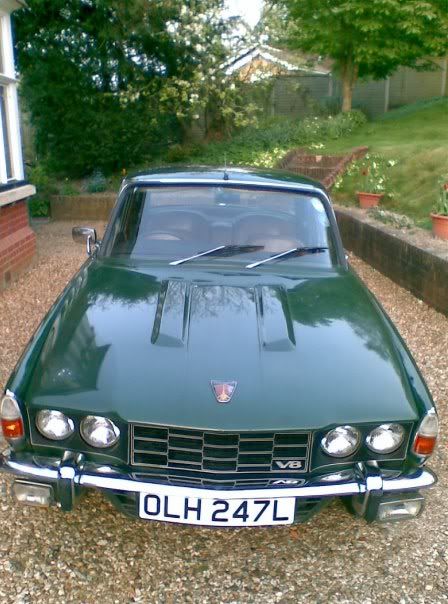corazon
Well-Known Member
Hi everyone, thought it about time i made a post, my '72 V8 Auto cameron green has started to run very poorly after making some changes.
I'll put it in perspective.
I bought the car in April of this year, with only two previous owners from new. Had a friend weld the underbelly and replace a cracked exhaust manifold to get through the MOT. Ran great up until now, apart from overheating in traffic, mainly from a weepy radiator and i believe an inadequately small kenlowe. The rad has now been soldered and i put on a new cap. I have also fitted a metal blade original style fan, as this had been removed when kenlowe was fitted. Is there a good reason why they removed the original? Add to that a new fanbelt, and temp hasn't even reached the middle of the green even when in traffic.
So with that done, i thought i'd replace points, condenser etc as points were really old, one was badly pitted. After nearly a day of trying to remove the wrong size screw holding the points plate down(!), i had the new parts in. I also had to replace the makeshift dwell angle adjuster, a threaded screw and two nuts, with a similar set up. Set the gap with feeler guage and everything fires up ok.
Having noticed the transmission fluid was extremely low, i topped up with the only bottle of tqf i could get my hands on nearby.
However, now everything is up in the air!
The idle is extremely low, between 3 and 4 and obviously wants to stall all the time. The choke doesn't seem to help at all. Performance is now hilarious.
Pulling out a junctions is a scary proposition, as it takes about five seconds to pick up any kind of speed (it used to fly like a rocket).
Gearchange is a lot smoother now, hadn't realised how smooth it was meant to feel! But is erratic in changing.
Do i just need to retune everything up? I'm still very new to working on cars, and don't have any timing or carb balancing tools. I could always take it to someone to tune, but was just wondering if you guys had any opinions on the matter?
Thanks, i've been reading posts on here for a couple of months now.
Jim
I'll put it in perspective.
I bought the car in April of this year, with only two previous owners from new. Had a friend weld the underbelly and replace a cracked exhaust manifold to get through the MOT. Ran great up until now, apart from overheating in traffic, mainly from a weepy radiator and i believe an inadequately small kenlowe. The rad has now been soldered and i put on a new cap. I have also fitted a metal blade original style fan, as this had been removed when kenlowe was fitted. Is there a good reason why they removed the original? Add to that a new fanbelt, and temp hasn't even reached the middle of the green even when in traffic.
So with that done, i thought i'd replace points, condenser etc as points were really old, one was badly pitted. After nearly a day of trying to remove the wrong size screw holding the points plate down(!), i had the new parts in. I also had to replace the makeshift dwell angle adjuster, a threaded screw and two nuts, with a similar set up. Set the gap with feeler guage and everything fires up ok.
Having noticed the transmission fluid was extremely low, i topped up with the only bottle of tqf i could get my hands on nearby.
However, now everything is up in the air!
The idle is extremely low, between 3 and 4 and obviously wants to stall all the time. The choke doesn't seem to help at all. Performance is now hilarious.
Pulling out a junctions is a scary proposition, as it takes about five seconds to pick up any kind of speed (it used to fly like a rocket).
Gearchange is a lot smoother now, hadn't realised how smooth it was meant to feel! But is erratic in changing.
Do i just need to retune everything up? I'm still very new to working on cars, and don't have any timing or carb balancing tools. I could always take it to someone to tune, but was just wondering if you guys had any opinions on the matter?
Thanks, i've been reading posts on here for a couple of months now.
Jim



